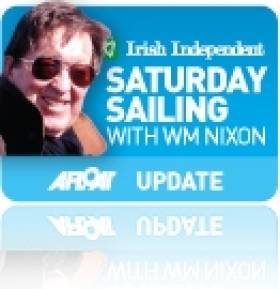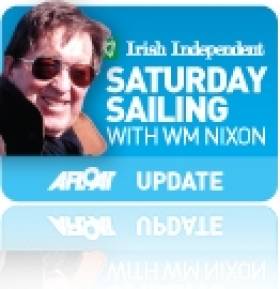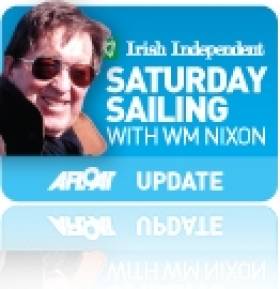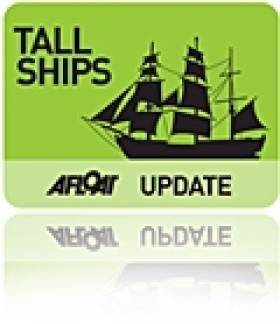Displaying items by tag: W M Nixon
Standing Up in a Hammock
#STAR SAILING – The last time anyone said the Olympic buildup is great crack for the participants must have been way back in the previous millennium. That's if it was ever said at all at any time since the first Olympics in ancient Greece, and on current form the Greeks -ancient or otherwise - just don't do great crack.
But in Olympic sailing, as in every other discipline in the five ring circus, the first thing that seems to fall by the wayside is the notion that it's all supposed to be sport. As for any anticipation of the participants having some sweet and uncomplicated enjoyment through sport, let alone any fun, that doesn't really figure at all.
Oh for sure, there are people whose stupendous sporting gifts and their enjoyment of them is truly life-enhancing. But they seem as rare as hen's teeth. For every Ronnie Delany and Usain Bolt ulluminating the planet, there seem to be zillions of grey little wannabee Olympians battling doggedly towards some goal whose only real reward is that, in winning it, they will manage to deprive someone else equally uninspiring of their narrow satisfaction.
It's bad enough when we hear people talking endlessly of their struggles, but regrettably that's too seldom. Usually, we're dished up wall-to-wall grim struggles. Always grim struggles. For much of the Olympic buildup, the Grim Struggle Is Your Only Man.
So let's hear it for the Olympic Star Class boat, which is so crazy it has to be fun. The basic design of the hull was created many years ago for something as gentle as sailing on the placid lakes of the American south, where your greatest excitement might be an alligator attack. But as 'gators generally didn't find Star boats a toothsome morsel, the big challenge sailing them on sleepy lakes was to stay awake.
To liven it up, somebody took a Star boat racing on the sea, which was daft. But others followed suit all the way down the line to becoming an Olympic class. Some Olympic sailing venues are pretty much open sea stuff – this August's sailing Olympiad at Weymouth in southern England is one such. In livelier Weymouth weather, the Star is a boat which would be relished by folk who think the perfect way to have sex is standing up in a hammock.
On the sea in breezy weather, the Star Class boat is a floating torture chamber. The only reason the Spanish Inquisition didn't have a fleet of them – painted black, of course - was because they hadn't been invented. That said, they've been around for a very long time. So they're supposed to get the chop as an Olympic class after this year's event. But as two of Brazil's greatest sports heroes in any discipline, Robert Scheidt and Torben Grael, are Star sailors, sensible folk wouldn't bet against the Star being big in Brazil's Olympics in 2016.
They deserve their place in the sun for putting the sport and the fun back into top class sailing when their World Championship concluded at Hyeres in southern France last weekend. Admittedly, the top ten had long since qualified to be their national Olympics representative, so this allowed pure sport to emerge as the dominant flavour. But with ten crews - including Ireland's Peter O'Leary & David Burrows - in with a shout of being the new world champs and it all coming down to the final race, it was game on, and then some
Robert Scheidt and Bruno Prada won by an acclaimed hairsbreadth, because until that final race, through the preceding Hyeres Olympic Week and for much of the worlds the dominant crew had been Olympic superstars Ian Percy and Bart Simpson of Britain. So the Brazilians have brought it back to life, some people might actually have had some fun, and even if the Irish duo were pipped for a Bronze Medal by the Danes, their solid fourth and performance generally really does bode very well indeed for Weymouth.
W M Nixon's sailing column is in the Irish Independent on Saturdays
Kenny Reads it Right to Win the Race to the USA
#VOLVO OCEAN RACE – How long can City Fathers maintain their Welcoming Committee smiles for incoming race boats? It's a question which was uppermost in Miami earlier this week, as the great and the good awaited the arrival of the leaders in the Volvo Ocean Race.
In this case, the answer had to be three days. A week ago, Kenny Read and his team on Puma were hanging onto a slender lead from Chris Nicholson with Camper, after racing more than 4,000 miles from Itajai in Brazil. At usual Volvo 70 speeds, a Sunday finish in Miami was a possibility - just the job in a festive city with a large Hisapanic population ready to party.
But the Bahamas decided otherwise. They must be strict Calvinists down there. An ordinary high pressure area over the islands found even higher pressure within itself to become an extremely high pressure system, and an almost complete calm reigned over a wide area, right across the racers' track.
For sure it was sunny, and through the vividly moonlit nights there was no chill. But for shoreside crowds and frustrated crews, this was small consolation. Just to add to the pain, the boats far astern were still tearing along in the full trade winds, with Franck Cammas and Damian Foxall and their team on Groupama staging a real Lazarus job to get through overall points leader Telefonica and sail within nibbling distance of Puma and Camper.
But in conditions in which Puma is supposedly not at her best, Kenny Read kept his cool, and crawled along the last 200 miles with all the intensity of an Olympic race. Finally, they were shaping up to finish late Wednesday afternoon. But the weather hadn't finished. While things were serene at sea, a massive thunderstorm built up over Miami, and winds of 40 knots started to blow away bits of the tented Volvo Race Village. It had to be closed to the public for safety reasons. You couldn't make it up. But by the time Puma came sweeping into the harbour to clinch her win, the thunderstorm was moving inland, the village was re-opening, the bands played on, and the welcoming committee had grins from ear to ear for an American win.
Racing resumes in a week's time with the In Port event in Miami, and then they're on their way next day Transatlantic to Lisbon, thence to Lorient, and finally to the finish in Galway. Chinese-Irish entry Sanya rejoins the fleet in a week's time, meanwhile the leaderboard is: Telefonica 164 pts; Groupama 153; Camper 149; Puma 147; Abu Dhabi 68; Sanya 25.
When Wednesday May 9th was set as the day for the presentation of the Mitsubishi Motors/Irish Independent "Club of the Year 2012" award to the National Yacht Club in Dun Laoghaire after they'd been adjudicated the winners back in January, everyone had visions of a perfect summer's evening garden party sort of celebration.
No way, as it turned out this week. There was much better weather in March. But the National's superb clubhouse maintains a very pleasant warmth, and the place was packed out with a convivial crowd, so it was summer in every other way as Commodore Paul Barrington accepted the veteran ship's wheel trophy from Billy Riordan of Mitsubishi Motors.
It's the fifth time the National have won the trophy in its 33 years, and Irish Sailing Association President Niamh McCutcheon praised the club and its members for their sailing enthusiasm and exemplary level of voluntary effort afloat and ashore.
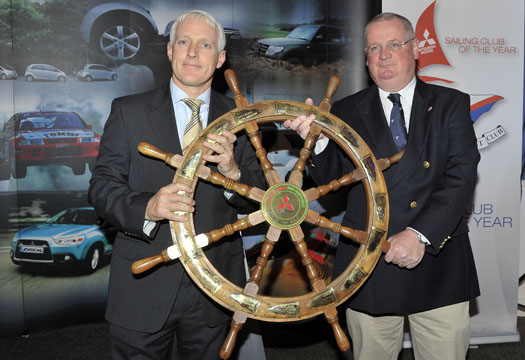
Billy Riordan (left) of Mitsubishi Motors and National Yacht Club Commodore Paul Barrington with the Club of the Year Ship's Wheel Trophy on Wednesday. Photo: Michael Chester
As the National is already well represented in the forthcoming sailing Olympics with Annalise Murphy a top contender in the Women's Lasers and Jack Roy one of the 16-strong international racing administration team, everyone was delighted with the news that Ireland's sailing squad has been increased with the qualification of James Espey for the Men's Lasers, while Peter O'Leary and David Burrows finished fourth overall in the current Star Worlds.
O'Leary and Burrows Stay in the Frame
#OLYMPIC SAILING – Ireland's Olympic Star Class crew of Peter O'Leary (Cork) and David Burrows (Malahide) have kept themselves in the frame with sixth overall in a class of 25 boats racing at the French Olympic Week at Hyeres on the Mediterranean coast.
But as with everything to do with Olympic sailing except the final result at the main event itself in August, it's something which can be read in several different ways. For sure, they're ahead of some formidable international competitors on the leaderboard. But equally, while it's a quality fleet, some notable names are conspicuously absent.
And some were and weren't. Absent, that is. Current World Number One Robert Scheidt of Brazil, crewed by Bruno Prada, went out in the first race, and won. Then he seems to have disappeared, but showed up for Races 7 and 8, getting two thirds.
For those who stayed with the game, the best show has been by highly fancied British crew of Iain Percy and Andrew Simpson. Having been selected for August's big one, they'd eased back a bit over mid-winter, but in Hyeres they've re-geared like several rockets, and knocked up a scorecard of 2,5,4,1,1,1. They didn't have to finish the final race to win the points series going away, which is just as well, as they were dismasted
The O'Leary/Burrows listing was 4,10,11,7,7, 3, and 9, all of which they'd to carry as they'd a DNF in the final race with a broken forestay. In the 49er class, Ireland's Ryan Seaton and Matt McGovern concluded with a welcome upward curve, taking 19th in the fleet racing with a scoreline of 11, 14,13,7,7, 21, 10, and 6, discarding a DSQ.
The fleet in the Volvo Ocean Race have been having a nervy time of it, getting through the light airs towards the Equator as they race the 4,800 miles from Brazil to Miami, with a huge reward waiting for whoever breaks through a waving cold front first. Beyond it, the front-runner to the northeast trade winds will have an enormous boost to lengthen away.
The in-port race in Itajai last Saturday provided a useful gain for Franck Cammas, Damian Foxall and crew on Groupama – they won - while initial leader Telefonica, which is also overall points leader, threw half a dozen points away by going round the wrong marker buoy.
In the long haul to Miami, Kenny Read with Puma has been showing best, with Chris Nicholson next in line in Camper, followed by Telefonica, but positions may have another shakeup as they round the corner of Brazil at Recife.
There's been encouraging news for Irish sailing in two very different branches of the sport. UCD were a great force in universities sailing in Ireland in times past, but they'd had a drought until this spring, when it all leapt to life for them again with the overall win in the Irish Universities Nationals.
They then went to the British Opens as Irish representatives, and showed it wasn't a flash in the pan by coming home with the bronze. UCD's team were Simon Doran & Aoife Coffey, Barry McCartin & Eimear McIvor, and Aidan McLaverty & Bella Moorehead. That's not the end of it by any means, as the Dublin college will now be providing Ireland's team for the Student Worlds in France in October.
Cork voyaging couple Stephen and Aileen Hyde are now shaping their course out of the Caribbean with their 56ft Oyster after adding racing success to the circumnavigation which they completed last year. With son Stefan, - former Helmsman's Champion of Ireland - joining the ship with three keen racing crew, they took part in the International Oyster Regatta at Tortola, winning their class and finishing second overall to the successful rang boat Scarlet Logic, an up-dated machine which dominated the results in the recent RORC Caribbean 600 race. For a veteran cruising crew, this racing success was the icing on the cake – they'll return to Ireland this summer.
W M Nixon's sailing column is in the Irish Independent on Saturdays
Dublin Bay is Focus for Youth Sailing this Weekend
#ISAYOUTHNATS – Dublin Bay is the national sailing focus this weekend, with more than 400 junior sailors hitting the water for the ISA Mitsubishi Youth Nationals. On the threshold of the season, it's always an event alive with anticipation. And with the Youth Worlds scheduled for the same venue in July, the pressure is already way off the top of the scale.
Leading Optimist dinghy sailor Sophie Browne (14) of Tralee, youngest ever helm to take the coveted "Sailor of the Month" title after her Silver Medal in the Opty Worlds in New Zealand in December, has already launched her 2012 season with considerable success in Denmark, where she won the recent International Consul's Cup series with a strong performance which moved the official reporter to suggest that the Kerry sailor had moved up a gear relative to all the other sailors.
As for other contenders on the bay this weekend, east coast sailor Megan Parker (13) of Skerries made the trek to the Lake Garda International Optimist Regatta on Easter weekend, and finished 19th. You might think that is scarcely an exceptional achievement. But the legendary Garda event attracted 806 entrants, which is simply beyond most folk's imagination. Merely to find the finish line through a plague of boats like that is surely deserving of some sort of award from the Royal Institute of Navigation. And to get into the top 20 merits the ringing of church bells back home - as sixth girl with nine top twenty placings and four top tens, Megan Parker did very well indeed.
With the multi-class Spring Warmer Series getting under way at Howth, Irish Cruiser Racing Association Commodore Barry Rose reminds all would-be competitors at the ICRA Nationals at the same venue in late May that discounts on entry fees cease after this weekend. With the organising committee chaired by Nobby Reilly, the Nationals from May 25th to 27th are shaping up to provide top level racing which positions everyone very neatly both geographically and tune-wise for the Scottish Series four days later, time-honoured as a happy hunting ground for Irish boats.
Meanwhile the RORC's Easter Challenge in the Solent last weekend was quite a silverfest for Wicklow designer Mark Mills. Boats from his drawing board were outright winners in two of the five classes, and he had a major input into the re-design of a third class winner.
The well-seasoned Summit 40 Tokoloshe (Mike Bartholomew, South Africa) topped IRC 1, 9 points clear of Anthony O'Leary's second-placed Ker 39 Antix, with round Ireland winner Tonnere de Breskens back in fifth. A new Mills production boat, the MAT 1010 Matilda (Louise Morton, Cowes) won IRC 3, and the veteran MG 30 Checkmate XV (Nigel Biggs, North Wales & Dublin Bay) won IRC 4 with more than a little help from a new Mills-designed keel and rudder. The Mills office has also scored success in the 600-mile China Sea Race from Hong Kong to the Philippines, winning IRC 1 with the 40ft one-off Mandrake (Fred Kinmonth & Nick Burns).
Looking to the coming season, that second place for Antix was encouraging for defending Commodore's Cup skipper Anthony O'Leary, but inevitably simply finding a team of three boats for Ireland for the biennial Commodores Cup in these straitened times poses problems for ICRA. However, 17 boats have already nominated for the British trials, and even with two or three Brit teams in prospect, there'll be good boats going spare, plus we hear of one or two interesting rustlings in the undergrowth.
NON-BREAKING NEWS
Argentine designer Juan Kouyoumdjian, who's based in Alicante, has fired off a broadside at those who suggest the damage-scarred current generation of Volvo 70s need their specifications and building standards up-graded.
For those who were away on Easter Retreat, the news is that the three leaders of the Auckland-Brazil stage (Leg 5 of the race) have now reached port, with Kenny Read's Puma just staving off an extraordinary challenge by overall leader Telefonica (Iker Martinez). After a 17-hour pit-stop at Cape Horn for "non-essential but sensible repairs", Martinez and his team sailed north with a new wind pattern and reduced the Puma lead of hundreds of miles to less than one mile before slipping back a little at the finish, but still taking a very close second.
Groupama (Franck Cammas) had been dicing with Puma all the way up the Atlantic, but her rig came down within 700 miles of the leg finish. With a jury rig, they still managed to finish and take third. Only Camper is still racing, battling up the south Atlantic after a prolonged stop for repairs in Chile. But all three other boats are out of Leg 5, and are now being shipped to an Atlantic port with various levels of hull structural damage. Thus critics have been saying that the hulls of Volvo boats aren't built strong enough, but Juan K is having none of this, and on Thursday he let fly:
"With our three boats safely in Brazil.....I believe we are presented with an intentional manipulation of the truth".
"There is a common, spread notion that ALL the participants in this VOR have structural problems, that the situation is unacceptable and that something needs to be done for the future. A fundamental distinction needs to be done between the mast breakages and the rest, and whilst I think it is very important to understand what caused so many mast failures, it is a travesty of the truth to put ALL designs in the same basket when it comes down to "other" structural issues......"
"Puma won Leg 5 without a major structural problem....Telefonica finished second with a hull delamination in port mid bow which did not prevent her from racing....(her) pit stop in Cape Horn was not a necessity but rather a very clever strategical decision based on having 3rd place assured....Groupama has sailed on her own means to Brazil without structural problems..."
Spitting fire by now, he concludes: "....avoid putting in the same basket the good work and brilliance of some engineers with that of others which are clearly not the same".
Them's his sentiments, and Juan K gives it from the heart. But there's only one Juan Kouyoumdjian, and he can't design and engineer ALL the boats in the Volvo Ocean Race, even if there is another edition of the VOR in its present form.
Because the news that a blue chip supporter like Groupama is pulling out of all sailing sponsorship after this race is over (and all football sponsorship too, after current contracts are completed), makes any future VOR scenario even more of a guessing game. Maybe we'll end up with something involving only the burgeoning BRIC economies (Brazil, Russia, India and China) - perhaps a Pacific Rim circuit with a quick jaunt round Cape Horn to Brazil? What would Paddy Power give odds on?
W M Nixon's sailing column is in the Irish Independent on Saturdays
Tall Ship Interests Plan Replacement for Asgard II
Ireland could yet have a Tall ship to replace the Asgard II and the Lord Rank, if a new sailing group formed to press for a replacement is successful. The news is in this morning's Irish Times newspaper. Groups representating different interests from maritime to tourism to economic are getting together for a special conference on March 26th in Dublin Port. The full Irish Times story is HERE. Next week in Afloat magazine's March/April issue an article called 'Tall Order for Ireland' gives all the details on the conference. It includes a 'call for contributions' from key stakeholders who would support a Tall Ship for Ireland. More details HERE. And in a separate article WM Nixon looks at the realities of national sail training in the 21st Century. This new move on a replacement seems to have entirely appropriate timing; Asgard II was commissioned in Arklow 30 years ago this week, on March 7, 1981.
Looking for further reading on Tall Ships in Ireland? Click the links below:
Click this link to read all our Tall Ships Stories on one handy page
Previewing Ireland's Tall Ships 2011 Season
Can Ireland Get a New Tall Ship?
Afloat's March/April Issue Out Next Week!
Is there no end to the achievements of Irish boaters against seemingly impossible odds?
The winter may have been a time of hibernation for some of us but as the stories in Afloat's March/April issue will bear out Irish sailors have been battling the elements all winter long.
James Carroll competed in January's Sydney-Hobart offshore race and, much closer to home, Paul A. Kay journeyed through snow and ice in December from Dun Laoghaire to a new marina on Valentia Island.
As if to prove a point that we're down but not out, a winter of results on foreign waters includes a win in the Mirror World Championships in Australia and a top Olympic result in Florida, USA.
They are gutsy performances from youth teams that shows, if nothing else, the next generation of Irish sailors is really up for a fight. All this plus lots, lots more on news-stands next week!
Selected contents from Ireland's only boating magazine include:
News
Surveyors Issue Boat Launch Warning, Buoyant Dinghies Buck the Market, Ice Diving in Ireland, German U-Boat Rediscovered in Cork Harbour, an Historic Trophy for South Pacific Dream Cruise, MGM open in Cork, Hugh Mockler joins Crosshaven Boatyard plus lots, lots more.
News Focus
A new masterplan for Dun Laoghaire harbour is badly needed but it needs buy in from all those that use it
Going Offshore
The tenth Dun Laoghaire to Dingle offshore race was launched in style
Marine Conference
Combating the downturn was the focus of a unique marine gathering on both sides of the Irish sea.

Gear Review
New dinghy gear, a new Crosshaven boot from Dubarry, a new raincoat for girls and an upgrade for Musto's MPX.

This Island Nation
The decision to shut down the fog signals was based on a detailed risk assessment. Tom MacSweeney on the loss of fog horns
Sailor of the Year
Anthony O'Leary of Cork is the Afloat.ie/Irish Independent "Sailor of the Year" in celebration of his outstanding achievements afloat nationally and internationally.
Tall Ships
W M Nixon looks at the realities of national sail training in the 21st Century.
Tall Ship Conference
Ireland could yet have a tall ship to replace the Asgard II and the Lord Rank, if a new group formed to press for a replacement is successful
Racing update
Ulstermen's World Title, Topper worlds for Dun Laoghaire, Two Irish campaigns line up for Figaro Race, SB3 Sailors Cry Foul at Dun Laoghaire Parking Fees and an Irish entry in the Moth worlds in Australia, Irish Mini 6.50 Campaign in Prospect.

Youth Worlds preview
Results achieved abroad this Winter are the backbone for further Irish youth
success

Figaro Preview
Two fledgling Irish La Solitaire du Figaro campaigns edged closer to the start line last month
Volvo Dun Laoghaire Regatta
Volvo Dun Laoghaire regatta has taken in 22 entries six months ahead of the first race of the biggest regatta in Irish sailing.

Fireball Worlds preview
Dun Laoghaire's Noel Butler intends to continue his winning run in the Fireball class this season but the year ahead doesn't look so easy as the World Championships come to Sligo
Sovereigns cup preview
Up to 30 Quarter tonners will be at the Sovereigns Cup this year including one from New Zealand.
Shiver to deliver
A journey through snow and ice from Dun Laoghaire to Valentia Island
Sydney-Hobart Race
Outside of the Volvo Ocean Race, the Sydney Hobart is one of the world's most challenging offshore races. James Carroll Raced it in January.
Inland
As the cuts begin to bite, it may be time to look at the British direction for our waterways, writes Brian J Goggin
Dubarry Nautical Crossword
Soundings
A Google aerial photo proves useful navigating for Baldoyle Estuary
- Anthony O'Leary
- Dun Laoghaire
- Tom MacSweeney
- Harbour
- MGM Boats
- Asgard II
- World Championships
- Dinghies
- Olympic
- Cork Harbour
- Valentia
- Mirror
- Dingle
- youth
- Lord Rank
- Island Nation
- Hugh Mockler
- Dubarry
- Tall ship
- brokerage
- sydneyhobart
- fog horn
- moth
- Mini 6.50
- Uboat
- Fireball worlds
- Sovereigns
- James Carroll
- Paul A. Kay
- Crosshaven Boatyard
- Baldoyle
- MPX
- W M Nixon


























